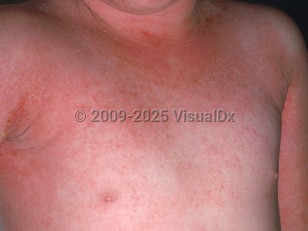Erythroderma in Child
Alerts and Notices
Important News & Links
Synopsis

The more common causes of erythroderma in adults are psoriasis, atopic dermatitis, mycosis fungoides, pityriasis rubra pilaris, and drugs. A number of medications have been reported to cause an exfoliative dermatitis, including but not limited to the following: allopurinol, antibiotics, antiepileptics, calcium channel blockers, opiates, gold, isoniazid, retinoids, lithium, phenothiazine, quinidine, thalidomide, and thiazides. (See also Drug Reaction Data, below.)
Rarer causes of erythroderma include seborrheic dermatitis, contact dermatitis, lichen planus, dermatomyositis, tinea corporis, actinic reticuloid, stasis dermatitis with autoeczematization, crusted scabies, inherited ichthyoses, and blistering diseases such as pemphigus foliaceus and bullous pemphigoid. Systemic diseases have also been associated with erythroderma, including systemic lymphoma and solid organ malignancies (eg, squamous cell carcinoma of the lung), as well as human immunodeficiency virus (HIV) disease. Around one-third of all erythroderma cases are idiopathic.
Sézary syndrome is a leukemic form of mycosis fungoides in which circulating atypical lymphocytes in the presence of erythroderma form mycosis fungoides.
Erythroderma may develop acutely over days, such as when there is a drug cause, or more slowly over weeks or months, such as in a severe dermatitis or psoriasis. The majority of the skin surface is red, scaly, and usually very pruritic. Systemic manifestations include peripheral edema, which is usually pedal, pretibial, or facial. Increased blood flow and increased fluid loss through the skin can lead to tachycardia and the possibility of developing high-output cardiac failure. The risk of this is higher in acute cases. There are also thermoregulatory imbalances, which produce hyperthermia more frequently, but also hypothermia. Generalized lymphadenopathy is the most common noncutaneous manifestation of drug-induced erythroderma and is seen in approximately half of all patients.
Vancomycin infusion reaction, formerly known as "red man syndrome," is a drug reaction typically caused by parenteral vancomycin. It has also been observed following intraperitoneal and oral use. Signs appear about 5-10 minutes after the start of the rapidly given infusion. The patient complains of generalized burning and itching, and an erythema spreads to involve the face, neck, and upper body. Other symptoms include chills, fever, dizziness, paresthesia around the mouth, chest pain, and dyspnea. There is significant hypotension. The reaction to vancomycin is due to an anaphylactic response mediated by IgE. The erythema usually subsides several hours after completion of treatment. Unlike other erythrodermic drug reactions, exfoliation is usually not present. The most severe reactions occur in patients aged younger than 40, especially children. Treatment with antihistamines relieves the symptoms, and giving hydroxyzine before the start of a vancomycin infusion lessens the erythema and pruritus.
Pediatric patient considerations: While adults are most commonly affected, erythroderma may rarely be seen in neonates and infants. Here, besides atopic dermatitis, psoriasis, and drug eruptions, rare inherited diseases are responsible, such as Leiner disease, Omenn disease (severe combined immune deficiency, erythroderma, lymphadenopathy, high IgE levels), Netherton syndrome, bullous congenital ichthyosiform erythroderma, non-bullous ichthyosiform erythroderma, and other inherited ichthyoses (eg, X-linked, lamellar; see also harlequin ichthyosis).
Codes
L26 – Exfoliative dermatitis
L27.0 – Generalized skin eruption due to drugs and medicaments taken internally
SNOMEDCT:
238992001 – Drug-induced erythroderma
45454 – Erythroderma
Look For
Subscription Required
Diagnostic Pearls
Subscription Required
Differential Diagnosis & Pitfalls

Subscription Required
Best Tests
Subscription Required
Management Pearls
Subscription Required
Therapy
Subscription Required
Drug Reaction Data
Subscription Required
References
Subscription Required
Last Updated:10/11/2021

